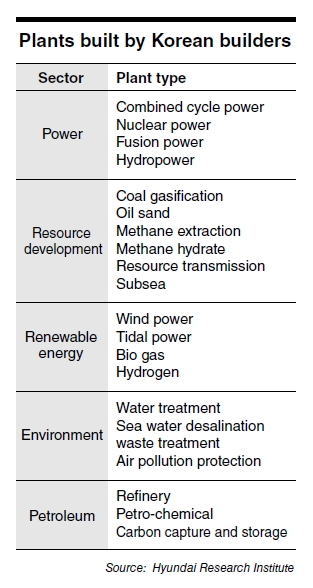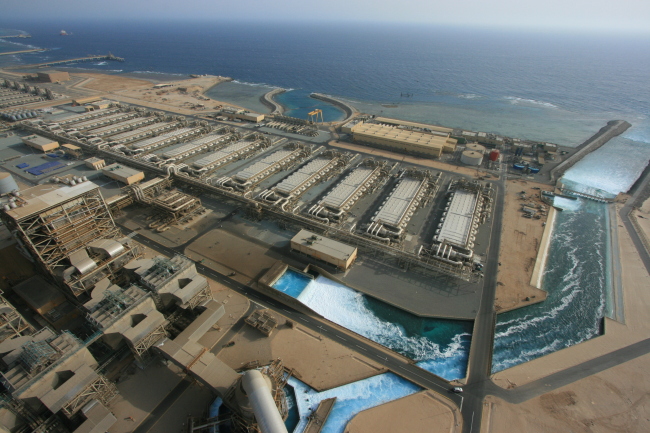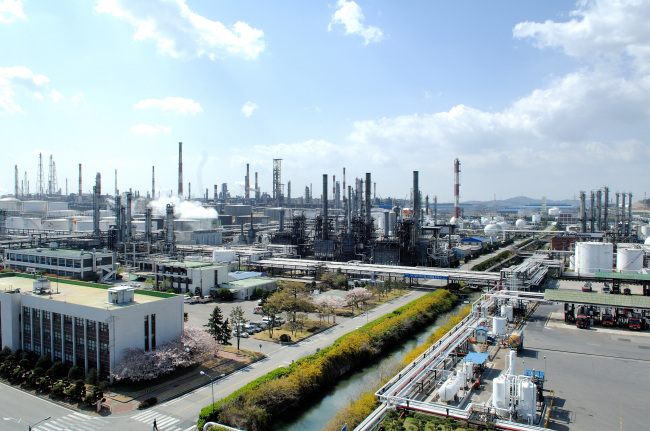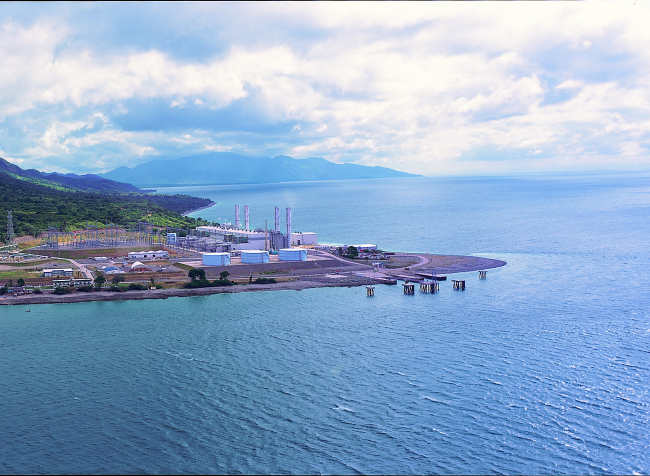[Power Korea] Industrial plant exports emerge as new growth engine
Korean builders, armed with industrial plant building experience and know-how, step up overseas penetration
By Seo Jee-yeonPublished : July 29, 2013 - 19:38
The Korea Herald is publishing a series of articles on infrastructure as part of its second installment of Power Korea. Korea’s success story is a 60-year-old tale written by not one, but many who worked to build one of the world’s most powerful nations from the ashes of war. This series features the development and global competitiveness of Korea’s infrastructure. The special articles were made in cooperation with the Ministry of Land, Infrastructure and Transport. This is the seventh and last part of the infrastructure series. ― Ed.
Korea’s manufacturing-based economic development model has promoted the nation’s plant construction industry.
In just 60 years, Korea has become a manufacturing powerhouse, producing all types of goods from steel and oil products to cars and mobile phones, based on its globally competitive industrial plant infrastructure. Along with the development of such infrastructure, Korea’s know-how in such plants has become globally recognized and emerged as a key export item in the 2000s.
For the first six months this year, Korean builders received $28.1 billion in industrial plant orders, according to the Ministry of Trade, Industry and Energy. The amount fell 1.9 percent from the same period last year due to the global economic downturn, but industry watchers forecast that global demand for Korean plants would rise again as orders from regions outside the Middle East grew.
The fall in Middle Eastern orders in the first half was offset by solid demand from Europe and Africa, of which plant orders more than tripled in the first half of the year. The share of orders from Europe and Africa to the total rose to 31.6 percent and 7.9 percent, respectively, the ministry said.
Evolution of the plant industry
The plant industry in Korea started as the government established and implemented the Five-Year Economic Development Plan in the early 1960s, a project designed to rebuild the country’s war-ravaged economy. During the implementation of the first government-driven economic development plan between 1962 and 1966, the two main focuses were on securing energy sources, including power and coal, and establishing industrial complexes.
In this period, the government recognized the importance of securing technology and competence through participation by domestic companies when building key industrial complexes. Thus, the government strategically carried out technology transfers and domestic companies participated in the government-led plant building projects for power generation, nuclear power, petrochemical and environmentally safe waste disposal. This served as an opportunity for the plants to secure engineering capabilities such as design and construction.
Based on the competence built over the years, the Korean plant industry switched its focus from domestic construction to overseas contracts in the 2000s. The volume of overseas contracts exceeded $10 billion in 2006, and it has managed to stay over $40 billion since 2010. The plant industry grew as much as the automobile, shipbuilding and semiconductor industries grew.
To establish a stable foundation for the industry amid global fluctuations in the 2000s, government policies began to shift focus more to technology advancement. This effort aimed to give Korea a technological edge in the global market.

Types of plants in Korea
-Environment-friendly plants
As pollution soared along with rapid industrialization and urbanization, plants were actively built nationwide to provide environment-friendly waste disposal. Currently, to dispose of general garbage about 20 large incineration facilities, which are able to incinerate over 4,500 tons per day, were built in Korea. Another 40 large incineration facilities incinerate more than 50 tons a day.
Korea’s manufacturing-based economic development model has promoted the nation’s plant construction industry.
In just 60 years, Korea has become a manufacturing powerhouse, producing all types of goods from steel and oil products to cars and mobile phones, based on its globally competitive industrial plant infrastructure. Along with the development of such infrastructure, Korea’s know-how in such plants has become globally recognized and emerged as a key export item in the 2000s.
For the first six months this year, Korean builders received $28.1 billion in industrial plant orders, according to the Ministry of Trade, Industry and Energy. The amount fell 1.9 percent from the same period last year due to the global economic downturn, but industry watchers forecast that global demand for Korean plants would rise again as orders from regions outside the Middle East grew.
The fall in Middle Eastern orders in the first half was offset by solid demand from Europe and Africa, of which plant orders more than tripled in the first half of the year. The share of orders from Europe and Africa to the total rose to 31.6 percent and 7.9 percent, respectively, the ministry said.
Evolution of the plant industry
The plant industry in Korea started as the government established and implemented the Five-Year Economic Development Plan in the early 1960s, a project designed to rebuild the country’s war-ravaged economy. During the implementation of the first government-driven economic development plan between 1962 and 1966, the two main focuses were on securing energy sources, including power and coal, and establishing industrial complexes.
In this period, the government recognized the importance of securing technology and competence through participation by domestic companies when building key industrial complexes. Thus, the government strategically carried out technology transfers and domestic companies participated in the government-led plant building projects for power generation, nuclear power, petrochemical and environmentally safe waste disposal. This served as an opportunity for the plants to secure engineering capabilities such as design and construction.
Based on the competence built over the years, the Korean plant industry switched its focus from domestic construction to overseas contracts in the 2000s. The volume of overseas contracts exceeded $10 billion in 2006, and it has managed to stay over $40 billion since 2010. The plant industry grew as much as the automobile, shipbuilding and semiconductor industries grew.
To establish a stable foundation for the industry amid global fluctuations in the 2000s, government policies began to shift focus more to technology advancement. This effort aimed to give Korea a technological edge in the global market.

Types of plants in Korea
-Environment-friendly plants
As pollution soared along with rapid industrialization and urbanization, plants were actively built nationwide to provide environment-friendly waste disposal. Currently, to dispose of general garbage about 20 large incineration facilities, which are able to incinerate over 4,500 tons per day, were built in Korea. Another 40 large incineration facilities incinerate more than 50 tons a day.


-Oil refinery and petrochemical plants
The oil refining and chemical industries are crucial businesses that provide materials for things that are necessary for life such as automobiles, buildings, fabrics, fertilizers, paint, cosmetics and detergents. The petrochemical industry in Korea was born as Ulsan Petrochemical Complex was organized in 1962.
The construction of the complex was completed on Oct. 31, 1972, giving the petrochemical industry a batch production system. The second petrochemical complex was established in Yeocheon, in 1979. In 1991, a third petrochemical plant began to operate in Daesan. And Korea’s petrochemical industry entered a new growth period.
-Thermal and hydraulic power plants
In Korea, the construction of power plants began to secure electricity for industrial complexes that were being established following the early economic development. Since Korea imports most of its energy resources from abroad, most industrial complexes are located near the coastline.
Five power generation affiliates of state-run Korea Electric Power Corp. run 24 thermal power generation plants nationwide, while three power plants are operated by private companies.

-Nuclear power plant
The construction for the 600,000 kilowatt nuclear power plant, the first unit of the Kori Nuclear Power Complex, began in 1971. The construction completion ceremony took place in July 1978, and Korea became the 21st country in the world to own a nuclear power plant.
Korea has 23 nuclear power plants. The total facility capacity equals 18,720,000 kilowatts.
Since the turn of the millennium, Korea’s efforts to export Korean standard power plant technology have accelerated. In 2009 it won a $40 billion UAE nuclear power plant construction project.
The Korean plant industry has evolved by applying foreign technologies to build its industrial foundations.
With the growth of the plant industry and plant related-industries, including parts and equipment, steel and materials are also well-established in Korea.
Korean builders, armed with a variety of industrial plant building experience and know-how, will step up entrance to overseas markets. A main task ahead of them is to strengthen their capability in engineering and design, industry watchers said.
By Seo Jee-yeon (jyseo@heraldcorp.com)









![[Kim Seong-kon] Democracy and the future of South Korea](http://res.heraldm.com/phpwas/restmb_idxmake.php?idx=644&simg=/content/image/2024/04/16/20240416050802_0.jpg&u=)







![[KH Explains] Hyundai's full hybrid edge to pay off amid slow transition to pure EVs](http://res.heraldm.com/phpwas/restmb_idxmake.php?idx=652&simg=/content/image/2024/04/18/20240418050645_0.jpg&u=20240418181020)

![[Today’s K-pop] Zico drops snippet of collaboration with Jennie](http://res.heraldm.com/phpwas/restmb_idxmake.php?idx=642&simg=/content/image/2024/04/18/20240418050702_0.jpg&u=)